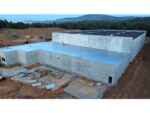BAE Systems has unveiled a new long-endurance autonomous submarine prototype named “Herne,” marking a significant step in the UK’s push toward uncrewed undersea capabilities. Designed to operate independently for extended durations without human intervention or tethering, Herne is being developed in partnership with the Royal Navy and the UK Ministry of Defence (MoD) as part of efforts to modernize underwater warfare and surveillance operations.
Introducing Herne: A Large Displacement Autonomous Underwater Vehicle
The Herne platform is classified as a large-displacement autonomous underwater vehicle (LDUUV), measuring approximately 17 meters in length. According to BAE Systems’ official release and corroborating defense sources including Naval News and Janes, the vehicle is designed to conduct intelligence, surveillance and reconnaissance (ISR), seabed warfare support, anti-submarine warfare (ASW) enabling tasks, and potentially mine countermeasure (MCM) operations.
Unlike smaller UUVs typically launched from surface vessels or submarines for short missions, Herne is intended to operate independently from shore or forward-deployed locations. Its modular payload bays suggest flexibility in mission configuration—ranging from sonar arrays and EW packages to environmental sensors or even future offensive payloads—though no kinetic armament has been confirmed at this stage.
The vehicle is currently undergoing testing at BAE’s Devonshire Dock Hall facility in Barrow-in-Furness. Sea trials are expected to follow in late 2025 or early 2026 off the coast of Scotland or within controlled MOD ranges.
Technical Features and Autonomy Stack
While detailed specifications remain classified or undisclosed due to operational sensitivity, available information indicates that Herne incorporates advanced autonomy algorithms developed by BAE’s R&D teams alongside partners such as Cellula Robotics (Canada), SeeByte (UK), and L3Harris.
- Navigation: Likely employs inertial navigation systems (INS) augmented by Doppler velocity logs (DVL), acoustic positioning systems such as USBL/SSBL when surfaced/submerged intermittently.
- Endurance: Estimated endurance ranges from several days up to potentially weeks depending on mission profile; power source not disclosed but likely includes lithium-ion battery banks with potential for fuel cell integration in future iterations.
- Sensors: Multi-mode sonar suite expected—potentially synthetic aperture sonar (SAS), side-scan sonar (SSS), forward-looking sonar—for obstacle avoidance and seabed mapping; additional EO/IR sensors may be included for surface operations.
- C2 Integration: Designed for compatibility with NATO-standard C4ISR networks; expected to interface via Link-16 or bespoke acoustic modems during submerged ops.
The autonomy stack reportedly supports adaptive mission planning with onboard decision-making capabilities based on environmental inputs—a key requirement for persistent unmanned maritime systems operating beyond line-of-sight.
A Strategic Capability Shift for the Royal Navy
The development of Herne aligns with broader Royal Navy ambitions under Project CETUS—a program aimed at fielding large uncrewed underwater vehicles capable of strategic ISR roles across contested maritime zones. It also complements other initiatives such as the deployment of extra-large UUVs by allies like the US Navy’s Orca XLUUV program developed by Boeing-HII.
The UK’s Integrated Review Refresh 2023 emphasized investment into autonomous maritime systems across all domains. The Royal Navy’s experimentation arm—NavyX—has been instrumental in accelerating trials involving uncrewed surface vessels (USVs) like Madfox and now submersibles like Herne. The aim is clear: reduce risk to human crews while expanding persistent maritime domain awareness across littoral and deep-sea environments.
If successful, Herne could serve as a force multiplier by conducting pre-positioned ISR missions ahead of manned task groups or supporting anti-submarine warfare through passive detection roles without revealing friendly submarine positions.
Industrial Collaboration and Program Timeline
The prototype unveiled this month was developed under a £15 million contract awarded by the UK MoD’s Defence Equipment & Support unit. Key industrial partners include:
- Cellula Robotics: Provided expertise on pressure hull design and modular payload integration based on its Solus-LR experience.
- L3Harris Technologies: Likely contributor of communication suites and autonomy software modules used across NATO navies’ UUV fleets.
- SeeByte Ltd: Known provider of mission management software tailored for underwater vehicles; probable contributor to navigation/autonomy layers onboard Herne.
The current prototype represents Technology Readiness Level (TRL) 6–7. If sea trials validate performance expectations through 2026–2027, BAE expects initial operational capability (IOC) could be achieved before 2030 depending on procurement cycles. The platform may also be offered for export under carefully controlled licensing arrangements aligned with Five Eyes partners’ interoperability goals.
Tactical Implications and Future Outlook
The introduction of long-endurance autonomous submarines like Herne signals a shift toward distributed undersea operations where persistent sensors can monitor chokepoints such as GIUK Gap or Baltic Sea approaches without requiring continuous manned presence. This reduces logistical burden while complicating adversary targeting calculus due to uncertainty over platform location or status.
If equipped with modular payloads capable of deploying small sonobuoys or EW decoys—or even acting as communication relays between submerged assets—Herne-class platforms could play critical roles in multi-domain kill chains involving air-sea coordination against peer threats like Russia’s Northern Fleet or China’s PLAN submarine forces in Indo-Pacific scenarios if exported beyond Europe.
However, challenges remain around command-and-control assurance during GPS-denied operations, energy density limitations affecting submerged loiter time, legal frameworks governing autonomous weapons at sea if weaponization occurs later—and cyber resilience against spoofing/jamming attacks targeting acoustic links or onboard AI logic chains.
Conclusion
The unveiling of BAE Systems’ Herne marks an important milestone in British naval innovation toward uncrewed undersea dominance. While still at prototype stage, its development underscores growing global interest in large-displacement AUVs capable of persistent ISR roles across strategic maritime theaters. As sea trials progress into 2026–27, its success will depend not only on technical performance but also doctrinal integration within evolving NATO naval concepts centered around unmanned-manned teaming below the surface domain.
Sources
- “BAE Systems surfaces autonomous submarine,” The Register, Sept 11 2025 – https://www.theregister.com/2025/09/11/bae_systems_surfaces_autonomous_submarine/
- “BAE unveils new large AUV demonstrator ‘Herne’,” Naval News, Sept 12 2025 – https://www.navalnews.com/naval-news/2025/09/bae-unveils-new-large-auv-demonstrator-herne/
- “Royal Navy CETUS project details,” UK Ministry of Defence Press Office, updated Aug 2025 – https://www.gov.uk/government/news/project-cetus-underwater-autonomy-programme-update-august-2025
- “SeeByte supports BAE underwater autonomy programs,” Shephard Media, July 2024 – https://www.shephardmedia.com/news/naval-warfare/seebyte-supports-bae-underwater-autonomy-programmes/
- “Cellula Robotics Solus-LR platform overview,” Navy Recognition, March 2024 – https://www.navyrecognition.com/index.php/focus-analysis/naval-technology/13821-solus-lr-cellula-robotics.html
“`









